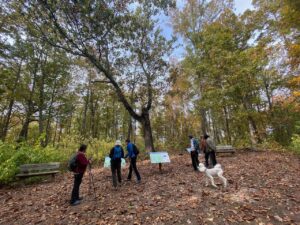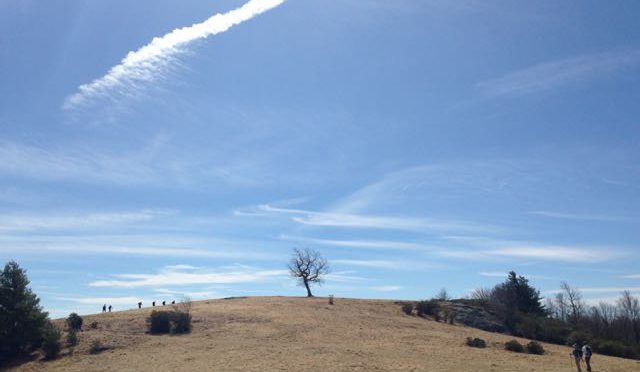Last week at the bookstore I picked up a copy of “The Language of Trees” and began thumbing through it. I randomly sampled a handful of the 50 or so essays and decided it was coming home.
 The essay that tipped my decision was the Introduction, in which writer Ross Gay recounted some of his favorite trees, from “the chokecherry tree in Verndale, Minnesota, where my grandpa parked his hospital-green ’68 Chevy pickup,” to “the beech tree in Vermont I met on a night hike two summers back.” That night hike tree reminded me of the imposing white oak that once appeared out of nowhere on a favorite night hike of the Mountains-to-Sea Trail. And that got me to thinking about some of my other favorite trees.
The essay that tipped my decision was the Introduction, in which writer Ross Gay recounted some of his favorite trees, from “the chokecherry tree in Verndale, Minnesota, where my grandpa parked his hospital-green ’68 Chevy pickup,” to “the beech tree in Vermont I met on a night hike two summers back.” That night hike tree reminded me of the imposing white oak that once appeared out of nowhere on a favorite night hike of the Mountains-to-Sea Trail. And that got me to thinking about some of my other favorite trees.
Cottonwood along Cherry Creek on the outskirts of Denver. Although I was just 7 or 8, this sprawling giant struck me first for its grandeur, then for its escape. Cottonwoods typically grow along water in the arid West; this one was along Cherry Creek as, at the time, it made its way northwest into Denver (the tree was later annexed and is now in Denver). It was no more than a half-mile from our house, yet it was an eternity away. It’s grandeur was heightened by the treehouse 10 feet up in its lowest branches: forbidden fruit for a chubby and fearful prepubescent. Eventually, though, I overcame the fear, if not the weight, to become a regular visitor. Initially, I was lured by the sweeping views from 10 feet up; soon, though, I discovered the real reason the treehouse was so popular: the stash of Playboys purloined by one Curt Bowen from his father’s collection.
 White Oak atop Medoc Mountain. Typically, we associated summits with views. In the case of Medoc Mountain State Park, topping out on the 300-foot peak where the rolling Piedmont meets the flat coastal plain means an audience with a stately white oak. Part of its impressiveness is the surprise that a grand oak stands amid slowly maturing hardwoods. Age — losing a limb here and there — has diminished the oak’s presence. But to us old-timers in particular its sight still signifies the accomplishment of bagging the highest peak in Halifax County.
White Oak atop Medoc Mountain. Typically, we associated summits with views. In the case of Medoc Mountain State Park, topping out on the 300-foot peak where the rolling Piedmont meets the flat coastal plain means an audience with a stately white oak. Part of its impressiveness is the surprise that a grand oak stands amid slowly maturing hardwoods. Age — losing a limb here and there — has diminished the oak’s presence. But to us old-timers in particular its sight still signifies the accomplishment of bagging the highest peak in Halifax County.
The long-gone loblolly at Umsteadl. I must have hiked the Company Mill Trail at Umstead State Park 50 times between 1992 and 1996, yet every time the appearance of an abnormally large loblolly in a ravine about 5 miles in took me by surprise. Loblollies are revered by timber-types for their sprint to maturity, typically going from sampling to sawmill in about 40 years. I have no idea how old this one was, but its girth and height (I couldn’t even see where it topped out) were roughly twice that of its contemporaries. The last time I saw it was on September 3, 1996, two days before Hurricane Fran hit. I wanted to witness the before-and-after effect of a hurricane; it was substantial. It would be 9 months before that part of the park would reopen. When it did, I discovered that mighty loblolly, and most of its neighbors, were kindling.
The pin oak out back. A tree needn’t be a looker to hold a special place. I’m reminded of this every time I walk out the back door and see the giant pin oak standing guard over our backyard. A lone branch hangs too low, the next one up is dead and needs to come down. Smaller dead offshoots are scattered throughout. This tree has likely been here since the house was built nearly a century ago, and I can’t help but think it’s played a role in the structure’s survival. It blocks a brutal late day sun in the summer, serves as a windbreak from storms blowing in from the west, and likely protects us in ways unseen. And it does so without complaint, about the ivy growing up its trunk or the mass of brush crowding its base. The tree deserves more than just admiration; it deserves an arborist.
Doughton Park’s lone tree. The first time I saw Doughton Park’s lone tree I wasn’t sure what I was seeing. It was a good half mile off, lonesome atop the crest of a mountain meadow. A hiker — albeit a really big one? A camel (ditto)? A tree simply didn’t register. What kind of tree grows on its own in an otherwise well-forested part of the country? And why? I still don’t know, for the allure of this tree is from a distance. And even though you eventually pass this tree — the Mountains-to-Sea Trail runs within 20 feet — by the time you get there you’re distracted by another of Doughton’s beauties: more meadows, the endless sky, the isolated rock outcrops. Maybe next time I’ll remember to slow down and take the time to get to know this loaner. Or at least get its name.
